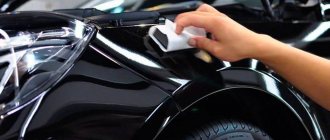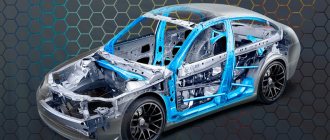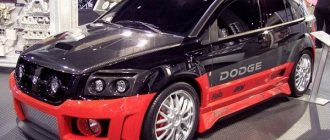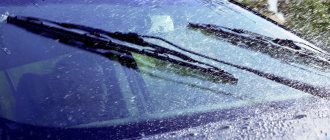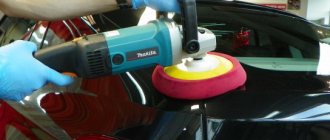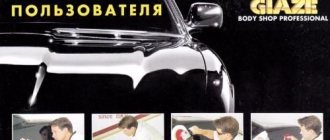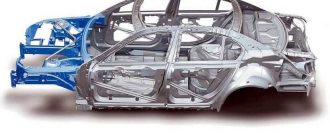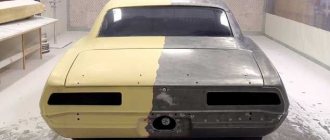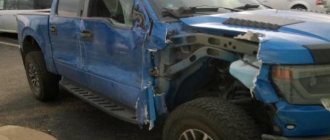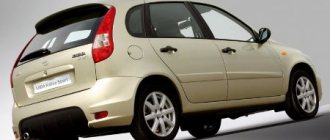Buying a used car requires great care. Particular attention should be paid to the geometry of the body, since deviations in the parameters may indicate possible deformations. As a result, the machine’s operational properties, controllability, and passive safety deteriorate.
You can check the car by external signs, as well as using special measuring tools. The simplest option is to close the doors, hood and trunk. There shouldn't be any difficulties here. In addition, there are other verification methods.
Checking the geometry of the car body
When a car leaves the factory assembly line, its body is absolutely symmetrical, that is, it has the correct geometry. This also allows you to arrange symmetrically all the parts and elements of the car that are attached to the car supporting frame.
As the car is used, the parts that form the skeleton of the car, despite the fact that they are initially rigidly fastened together, gradually shift. It happens, not a little, when significant mechanical damage to the car occurs due to an accident. In any case, the body geometry of a “lived” car is usually disturbed to a greater or lesser extent.
The broken symmetry of the car frame manifests itself in many ways, from the formation of non-standard gaps between the doors and the body, to serious problems with the car’s handling while driving. You can imagine what this could ultimately lead to. Therefore, checking the geometry of the body is important, not only when buying a used car, but also when operating your own.
There are several ways to determine the presence of body displacements. There are less accurate methods that are applicable at home, and more informative ones that are used at high-tech service stations. But, before determining the degree of displacement of body parts, it is worth considering in more detail what the definition of the geometry of a car body entails.
Let's summarize
Let's remember:
- Buying a used car from a dealership is not a guarantee of accident-free operation.
- Find out the damaged car yourself, especially if the repair is poor quality.
- Do not hesitate to ask a lot of questions to the owner, look under the rubber seals.
- If you don't have a thickness gauge, rent one.
- Does your car have no wheel alignment or problems with clearances? Body geometry needs to be checked.
More articles on used vehicles here.
Any opinions or ideas? Write in the comments, we will be glad!
What is the essence of body symmetry and the main reasons for its violation
In the technical support for each car you can find a section where the distances between certain points on the body are indicated. That is, the manufacturer assumes that these indicators must be constant for the normal operation of the same door mechanisms, wheel alignment adjustment, and a tight fit of the hood and rear door.
The main dimensions, changes in which directly indicate a violation of the body geometry are as follows:
- front and rear track width;
- wheel base length (center distance);
- the distance between the side members and their length;
- the dimensions of certain diagonals of the openings of windows and doors, the engine compartment, trunk and interior.
But the most significant are always the distances between the places where elements of its chassis, such as glasses, are attached to the vehicle base (side members). Spars are the basis for fastening many automotive components and mechanisms, the operation of which can be disrupted when the main load-bearing elements of the automobile frame are displaced.
Of course, the main reason for the violation of body geometry is usually mechanical influences. It is clear that in the event of a frontal impact, the dimensions of the engine compartment first change significantly. However, at the same time, although to a lesser extent, the distances between other control points, even such as the rear track, will change. That is, with significant mechanical damage, almost all control distances change, but to varying degrees.
The second main reason for the displacement of body parts is often a less-than-ideal road surface. In this case, the control points shift gradually, slightly and much more evenly.
Possible consequences
The correct geometric parameters of the car are the safety of the driver and passengers. Relative to the position of the power elements of the body, the angle of each of the wheels of the car is set. If the geometry is violated, the wheel alignment measuring system will never meet the standard. If the body moves relatively little, the technician will adjust the position of the wheels, but not for long.
Changes in geometry lead to the fact that the bottom is gradually deformed, folds appear in long body elements in the intervals between welding points, and the safety characteristics of the structure are noticeably reduced.
In a head-on collision, the engine should collapse underneath. If the dimensions of the body are violated, the engine will fly into the cabin, the risk of death for the driver and passenger increases by 50%.
Signs of broken geometry determined without measurements
It is wrong to think that minor distortions of the car frame can be ignored. After all, it is better to correct body deformations earlier than to wait until significantly misaligned car parts can lead to poor handling, which can cause very disastrous situations on the road. What can indicate that spatial changes have occurred to the car frame? Initial signs are usually the following:
- doors that do not close clearly (it is worth eliminating their possible sagging on the hinges);
- The slamming hood and trunk are getting worse.
These “symptoms,” especially if they appeared somehow simultaneously without the participation of significant damaging factors, should lead the car enthusiast to believe that the body has become deteriorating for some reason. Moreover, the degree of violation of the body shape will progress if the cause is not eliminated in time and the proper symmetry of the car is not restored.
If the situation is not intervened in time, the following signs will appear indicating that the geometry of the body is undergoing changes not for the better. The car will begin to lose control, first at high speeds, and then at medium speeds, with an absolutely serviceable chassis. This will indicate the curvature of the glasses, side members and other structural elements of the car frame.
If a car enthusiast is not indifferent to his car, as well as to his own safety, having noticed the first signs of deformation of the frame, it is worth measuring the control dimensions, which can be done less accurately, but independently, or with a high degree of accuracy, but at a service station.
We check the body geometry ourselves
As mentioned above, in the technical support you can find a section where control points are indicated, changes in the distances between which signal a violation of the required form. Now it’s even easier for car enthusiasts, because the layout of control marks for any car model can be found on the Internet if the “book” is missing for some reason.
The following measuring devices are used:
- special scale rod;
- calipers;
- roulette.
Measuring body geometry
Measurements with the first two tools are more accurate. However, they are not always available, so more often at home they use an ordinary tape measure.
Doorways and internal dimensions of the car's interior, trunk and engine compartment usually do not need to be measured. Here, deformation is determined by visually matching the fit of body parts.
Much more important in terms of diagnostics is measuring the distances between the control points of the base of the car frame. Before checking the body geometry, the car should be positioned above the inspection hole to facilitate access to the necessary points. It is worth considering that in order to measure some control distances you will have to remove some interfering parts. It is important to measure and evaluate the difference here:
- center distances on both sides;
- diagonals between control points;
- transverse distances between wheels on the same axle.
Definition
What is the geometry of a car body? How and where to measure it? The geometry of the body of any car is defined as a set of distances between control points that are set by the manufacturer. They provide for the exact position of all body parts relative to each other, which ensures the correct operation of components and mechanisms that are attached directly to the body itself. These distances include the diagonal dimensions of doorways, engine compartment and luggage compartment.
The most important are the distances between the support points, which play a supporting role for the parts of the chassis system. These include the distances between the side members, cups and other body elements on which the chassis is attached.
As a result, the wheelbase of the car, track width and other parameters that affect not only driving comfort, but also its safety depend on the correct body geometry. Therefore, special attention should be paid to body geometry. But first you need to figure out where its violation comes from.
Geometry assessment at a service station
Self-measurement and assessment of the condition of body parts are needed in order to draw a conclusion about the need for repair work, which can only be done efficiently in a good service station. There, before repairs, they will also be required to check and evaluate the condition of the body geometry, but with the help of more advanced equipment.
At modern, well-equipped technical services, the geometry of the car body is assessed using special stands that transmit the read information to a computer. But this is in the case of further repairs, since a large number of parts are expected to be removed. A preliminary assessment of the condition of the vehicle base is also carried out using appropriate measurements; high-precision laser devices are simply used as measuring instruments.
It seems that many car enthusiasts who read the article will have a desire to evaluate the correctness of the geometry of the body of their car, especially if they suddenly remember that the doors have somehow stopped fitting correctly, and the hood is getting worse into the lock.
Diagnostics at the technical center
In large populated areas you will definitely find a specialized technical center where they can carry out a complete diagnosis of the body geometry. Here we usually have the computer equipment we need, connected to a special stand. Diagnostics can be carried out using mechanical systems, special systems with fasteners, laser systems and computer diagnostics. The vehicle is first slightly disassembled and installed on a stand. After a kind of “scanning,” the data is sent to a computer, where a three-dimensional model of the car is created. The computer then conducts a comparative analysis of the machine data and the original model data.
The main advantage of such a check is maximum accuracy. But this method requires time and, of course, money, approximately you will have to spend several thousand rubles on this.
ALEX1887 › Blog › Body measurements
It’s a shame, having received a car from body repair at a service station or in a workshop, to find that it drives somehow wrong: it pulls to the side, does not obey the steering wheel well, does not hold the road well, although the alignment and camber of the front wheels have been checked more than once after the repair. An experienced motorist will immediately determine the reason: the geometry of the body is broken, and when asked “what to do!” will answer: “Replace the car.” Is it possible to avoid this and how, says Candidate of Technical Sciences A. NAUMOV.
By “body geometry” we mean the location of some of its points relative to each other and the axes of the car. These are, first of all, points that determine the position of the front and rear axles (and therefore the wheels), and the engine. Their displacement causes a deterioration in the driving properties of the car (and with it tire wear, increased fuel consumption, etc.). A change in the position of the machine's center of gravity also has a negative effect. The trouble is that when repairing a body deformed after a collision or due to severe corrosion, due attention is not paid to restoring the position of these basic points. In the best case, only two of the three technical requirements for monitoring geometric parameters are fulfilled (these requirements are set out in TU 37.009.021-88 “Acceptance, repair and release of passenger car bodies from repair by auto service enterprises”: check the size of the gaps in the doors, hood and trunk lid , as well as the installation angles of the steered wheels. The requirements regarding the relative position of suspensions and axles are often ignored. These same specifications provide a simple verification method, which boils down to measuring with a conventional tape measure the diagonal and longitudinal distances between the symmetrical points of the front and rear suspensions and bridges (Fig. 1).
The permissible difference between diagonal and longitudinal dimensions is no more than 0.4% of the larger value. It is useful for the service station client to know his rights, which are defined, in particular, in paragraph 4.5 of the same technical specifications: “The transfer of the body or its component to the customer can only be carried out with positive control results. Upon receipt of the body or its components, the customer has the right to check the quality of the work performed by the service station.” It must be said directly why service stations do not advertise these documents: it is very difficult to ensure the required geometry of the body base and control during the repair process without special equipment, and the “by eye” method that is used can lead to a conflict if the client is aware of control methodology will require eliminating deviations. How do reputable enterprises operate? At the AvtoVAZ Maintenance Center, the position of the attachment points of the front and rear suspensions, anti-roll bar and other critical chassis elements must be checked on a special slipway - BS-1 23.000. (Stands for the same purpose were also developed at Rosavtotekhobluzhivanie.) To the maximum extent possible, it reproduces the jigs used by the plant when assembling bodies. The slipway is a fairly rigid frame with brackets on which controlled holes are fixed in the elements of the underbody using pins. If the body is deformed, it will not be possible to install the pins. This control method is effective in eliminating complex damage when you have to disassemble the car, remove axles and gearboxes. It allows you to install new side members and other parts of the body base with guaranteed accuracy, eliminating the possibility of errors associated with measurements. But, as we see, it is very labor-intensive. Therefore, another method that does not require disassembling the car has become more widespread abroad. It is based on measuring the distances between the points indicated in the map of control measurements with which the manufacturer supplies its vehicles (Fig. 2).
What else happens when the body geometry is repaired poorly:
- uneven gaps in body panels (hood, fenders, bumper);
- displacement of the rear beam to the side even if the car is not pulled to the side;
- damage to ventilation and drain holes, which can lead to rapid rotting of the body;
- the windshield frame leaks and cracks form on it;
- displacement of the fastenings of components and assemblies leads to their accelerated wear (breakage of the drive belt and timing belt);
- presence of non-factory welds.
How to find out whether a car is damaged or not
The first step without leaving home is VIN from the seller . Search through free and paid databases, which will tell you everything about the history of the car.
Has it come to a live inspection? Let's take the next steps.
How to identify a damaged car
For a normal inspection you will need :
- Keen Eye : You need to be able to see differences in paint shades and differences in gap thickness. Or find a friend with good eyesight;
- Your own or rented thickness gauge ;
- Extra money for full diagnostics at a service center with connection to the brains of the car and (as a last resort) to check the geometry of the body.
After an accident, the car will be damaged by poor-quality repairs: painting, traces of parts being dismantled, etc. More details below.
The difference in paint shade is very noticeable in normal lighting.
Where and who sells used cars
Damaged cars are sold everywhere : car markets, online platforms, trade-in showrooms, consignment parking lots. Any used vehicle may have a sad history of accidents or crime.
Today it is popular and easy to search for a car while sitting at home at the computer. Minus : the car looks smooth and shiny, even if in reality there are many problems.
Pros : the car can be punched through the bases without leaving the spot.
How do they sell a damaged car from the officials? It’s not uncommon for a car to be bought by a private person after being written off due to an accident. It is restored and handed over to a trade-in, where it will be bought back without a thorough check by negligent acceptance staff.
There are a lot of examples of this, and after buying such a car you will have to give up only through the courts.
Initial inspection of the car upon purchase
Classic first inspection steps in good daylight:
- Sit by the headlight and look at the body along the side - the wrinkles will play in the light;
- Assess the condition of the headlights : heavily worn, worn out headlights indicate high mileage. If one is more transparent than the other, this indicates a possible accident and replacement of optics;
- Look at license plates : license plates get very wrinkled in an accident and are rarely restored to perfection. “Chewed” numbers are the result of a blow;
- Compare glass markings : the windows on the car have the same markings. A different windshield is not critical - they are often replaced due to wear and tear according to CASCO.
Severe wear of the headlight is a mileage indicator of 200-300 thousand kilometers.
External violation of gap symmetry
First inspection from a distance: all gaps along the contours of the doors, hood and trunk lid must be the same thickness. Is there a clear difference? The part was removed and put back into place crookedly.
The second inspection is thorough: we open and close all the doors, hood, and trunk one by one. When opening there should be no difficulty, no biting of the door handle or lock.
It should close easily. If you have to hit the door with force so that it closes normally, it could be a violation of the car’s geometry due to an accident.
Sometimes the gaps are uneven on new cars. The higher the class of the car, the less likely it is to perform poorly.
How to check whether a car is damaged or not with a thickness gauge
Next, look at the thickness gauge. To do this, we check each detail in several places:
- Indicators within 200 microns;
- Indicators for one part do not diverge by more than 30 microns.
Let's look around. Don't forget to open the doors and measure the pillars.
Step-by-step check of car body geometry
Body geometry is the correct location of control points on the body of your car. These points are set by the manufacturer; there must be strictly specified distances between them.
What if the audit reveals problems? The car may drift while driving, reducing safety. The main thing is that it is a sign of an accident or long-term use.
Why is it important to check body geometry?
The body is capable of deforming on its own : this is due to bumps, speed bumps, and heavy loads. It is recommended to check the body geometry once a year. If you track problems in time, it will be easier to fix them.
If you run the situation:
- the car will not keep the road;
- the doors, hood and trunk will become difficult to close.
If there are problems with geometry, it is impossible to set the wheel alignment correctly.
Signs of geometry violation
The first signs of problems : when hanging up, the door jams, the body plays and creaks on potholes.
Worse : the doors don't close properly, adjusting the locks doesn't help.
Bad : the car wanders at speed, the wheel alignment is normal.
Self check
To independently check the gaps and distances, you will need a table of factory indicators between the control points.
- Door openings diagonally and widthwise;
- Window and rear window openings ;
- Distance between glasses under the hood;
- The distance between the side members and their length.
Basic distances that you can measure yourself without contacting a service.
How to check geometry in the service
Did your self-check show problems with distances between control points or gaps? You need to take the car to a service station. They will check it with special equipment.
laser measurement systems at service stations : they will show which points have deviated from factory standards and by how much. For example, the right glass moves up and to the left or the displacement of one of the side members.
An example of how such a device works in the video.
How can you restore the geometry of a car?
You cannot restore the geometry yourself without experience. You'll only make it worse. It is necessary to estimate the cost of restoration work and how safe the car will be after repair.
There are two options for work:
- Branded services;
- Garage masters.
If the technician has extensive experience and good equipment, the price will not be lower than the service work.
A service with a bench for pulling the body will not be cheap, but it will make the car close to ideal.
